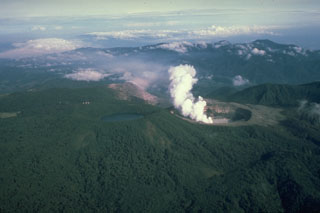Report on Poas (Costa Rica) — 16 January-22 January 2008
Smithsonian Institution / US Geological Survey
Weekly Volcanic Activity Report, 16 January-22 January 2008
Managing Editor: Sally Sennert.
Please cite this report as:
Global Volcanism Program, 2008. Report on Poas (Costa Rica) (Sennert, S, ed.). Weekly Volcanic Activity Report, 16 January-22 January 2008. Smithsonian Institution and US Geological Survey.
Poas
Costa Rica
10.2°N, 84.233°W; summit elev. 2697 m
All times are local (unless otherwise noted)
According to a news article, an eruption of volcanic material and gases from Poás rose to an altitude of 2.9 km (9,500 ft) a.s.l. on 13 January. The article also stated that a report from OVSICORI-UNA on 22 January revealed that an eruption of gas propelled material that did not fall beyond the cone. Authorities evacuated 20 people in the vicinity of the eruption.
Geological Summary. The broad vegetated edifice of Poás, one of the most active volcanoes of Costa Rica, contains three craters along a N-S line. The frequently visited multi-hued summit crater lakes of the basaltic-to-dacitic volcano are easily accessible by vehicle from the nearby capital city of San José. A N-S-trending fissure cutting the complex stratovolcano extends to the lower N flank, where it has produced the Congo stratovolcano and several lake-filled maars. The southernmost of the two summit crater lakes, Botos, last erupted about 7,500 years ago. The more prominent geothermally heated northern lake, Laguna Caliente, is one of the world's most acidic natural lakes, with a pH of near zero. It has been the site of frequent phreatic and phreatomagmatic eruptions since an eruption was reported in 1828. Eruptions often include geyser-like ejections of crater-lake water.
Source: La Nacion

